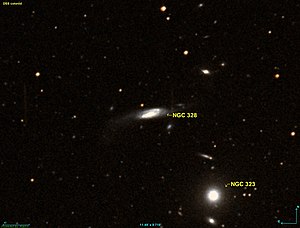NGC 328
| Galaxy NGC 328 |
|
|---|---|

|
|
| AladinLite | |
| Constellation | Phoenix |
|
Position equinox : J2000.0 , epoch : J2000.0 |
|
| Right ascension | 00 h 56 m 57.46 s |
| declination | -52 ° 55 ′ 27.2 ″ |
| Appearance | |
| Morphological type | SAB (rs) from / LLAGN |
| Brightness (visual) | 13.4 mag |
| Brightness (B-band) | 14.3 mag |
| Angular expansion | 2.6 ′ × 0.5 ′ |
| Position angle | 100 ° |
| Surface brightness | 13.5 mag / arcmin² |
| Physical data | |
| Redshift | 0.024494 ± 0.000097 |
| Radial velocity | 7343 ± 29 km / s |
|
Stroke distance v rad / H 0 |
(324 ± 23) x 10 6 ly (99.3 ± 7.0) Mpc |
| history | |
| discovery | John Herschel |
| Discovery date | September 5, 1836 |
| Catalog names | |
| NGC 328 • PGC 3399 • ESO 151-13 • 2MASX J00565758-5255262 • SGC 005445-5311.6 • GC 182 • h 2366 • AM 0054-531 | |
NGC 328 is a bar-spiral galaxy with an active galaxy core in the constellation Phoenix in the southern sky . It is estimated to be 324 million light years away from the Milky Way and has a diameter of around 50,000 ly. It is likely to form a gravitationally bound duo with NGC 323 .
The galaxies NGC 312 and NGC 348 are located in the same area of the sky .
The object was discovered on September 5, 1836 by the British astronomer John Frederick William Herschel .
